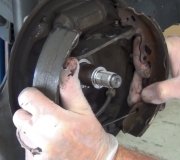That switch is turned on by a valve that shifts off of its centered position when there is an imbalance between the front and rear hydraulic circuits. In other words, it's due to a leak or some other reason pressure didn't build up as quickly on one part when the brake pedal was pressed. That valve can also be tripped when not following proper procedures when pedal-bleeding the brakes after some other service.
On Ford products that valve is not spring-loaded and is REAL frustrating to center it again. A special tool is made to hold the valve centered, ... As long as you know ahead of time you're going to be doing something that can cause it to shift. On Chrysler and GM vehicles that valve is spring-loaded, and it will usually reset itself but sometimes they stick in the corrosion that forms in the housing. A good jab on the brake pedal usually gets them freed up so they can reset. If that doesn't work, and you know, for example, that there was a leak in the rear hydraulic circuit, once it's fixed you can open the front circuit anywhere, then slowly press the brake pedal until the valve snaps free and the light goes out. At that point you have to hold the brake pedal right there until a helper closes whatever was opened to do this. If you let the pedal up before the circuit is closed, you'll draw air in. If you loosened the steel line at the master cylinder, if you're careful and patient, you can bleed any air out yourself by slowly pushing the brake pedal about one third of the way down, holding it there for half a minute to allow any air bubbles to float back up, then allowing the pedal to release quickly. The fluid returning to the master cylinder will wash any bubbles back up into the reservoir.
The issue now is why did that valve move? Was any brake work done recently or is there a leak somewhere?
Wednesday, September 17th, 2014 AT 9:27 PM



